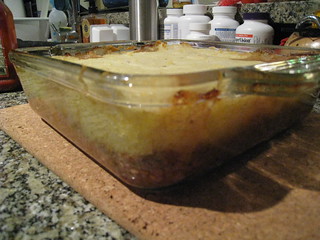Here it is, my "baccalao meravigliao", my own recipe, half eaten so you can see clearly what's in it: A bottom layer of baccala (codfish) and a top layer of potatoes topped with a golden gratin, herbs, capers, olives - yummy!
It's really very simple to do. Here's how:
- 1/2 lb cod fish fillet pieces - get it unsalted and ready-to-cook or buy a salted piece and leave it covered in fresh water, changing the water every 12 hours for 2 days, until thoroughly unsalted;
- 1/2 lb potatoes (better the red variety) peeled and thinly sliced;
- 4 garlic cloves, peeled, 2 whole and 2 minced
- 1/2 cup chopped onions (white or golden variety)
- 1/4 cup chopped fresh parsley leaves
- a pinch of sage
- peel of half a lemon (make sure it's organic, no pesticides!)
- small glass of white wine
- olive oil
- small cup of cream or, if you want to stay light, use creamed yoghurt, or a product like Skyr, or even just milk
- one whole egg, beaten
- Salt and pepper to taste
Cooking Method:
1. Get water boiling in a wide pot, add salt (to taste), sage, lemon peel and the 2 whole garlic cloves, flattened;
2. Cook the fish for 10 minutes (make sure the water only simmers);
3. With a slotted spoon, take the fish out of the water and let it cool; also take out the lemon peel and the 2 garlic cloves; discard the lemon but keep the cloves;
4. Add the sliced potatoes to the boiling water, cook for 10 minutes (until soft but not too soft, the slices must not fall apart); take them out and set aside; keep the water going on a low fire, you'll need it again as you cook the rest;
5. While the potatoes cook, fry the finely chopped onions and the 2 minced garlic cloves in 2 tablespoon of olive oil until fully cooked and transparent; add the 2 garlic cloves you've saved from the boiling water (see step 3); don't allow the onions to burn or take on any color: If it gets too dry and threatens to burn, add a ladle of the water in which the potatoes are cooking;
6. Clean the fish, scraping off the skin and making sure there's no bone left in it; break it in small pieces;
7. Put the fish in the pan with the onions and garlic, let it fry on a slow fire about 5 minutes then take it out of the pan making sure you leave about half the onions in the pan (you'll use the same pan to fry the potatoes in it next);
8. Lay out the fish in a well-oiled pyrex dish (or anything that can go in the oven); lay it out in a single layer and mix in the chopped parsley, capers and pitted olives cut in half (or sliced);
9. Put the potatoes in the pan that has the leftover onions, add a little olive oil if it looks too dry; fry 5 minutes then add a ladle of the cooking water, the cream, 1/2 glass of white wine and cook another 5 minutes to reduce the liquid until it turns cream-like (many potatoes will break down, but don't worry, they add to the sauce);
10. Take the pan out of the fire, add a beaten egg to the mixture, swirling it in fast so that it won't cook into an omelette but instead make the sauce feel very smooth; it should be as liquid as light cream (if it looks too heavy, add a ladle of the hot water you've kept simmering). Taste and adjust with salt and freshly ground pepper.
11. Cover the fish with the potatoes; sprinkle generously with grated dry bread crumbs for the gratin and dot it with butter;
12. Put in pre-heated oven at 180° (or 400°F) for 10 minutes, then turn on the grill and burn it! No, just let it turn golden but watch out, it burns easily!
To be eaten with a nice cold white wine...













